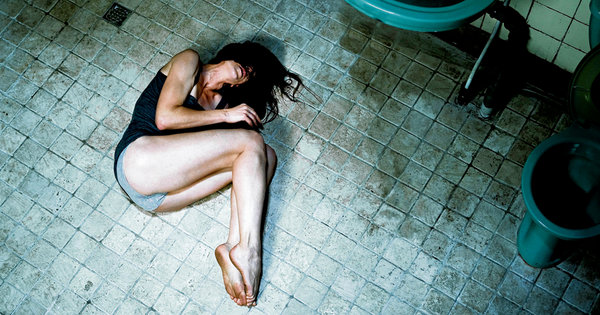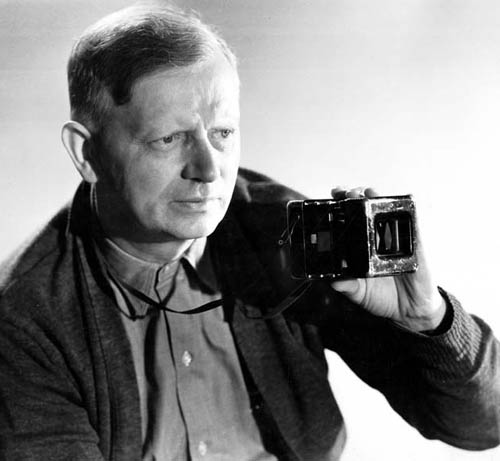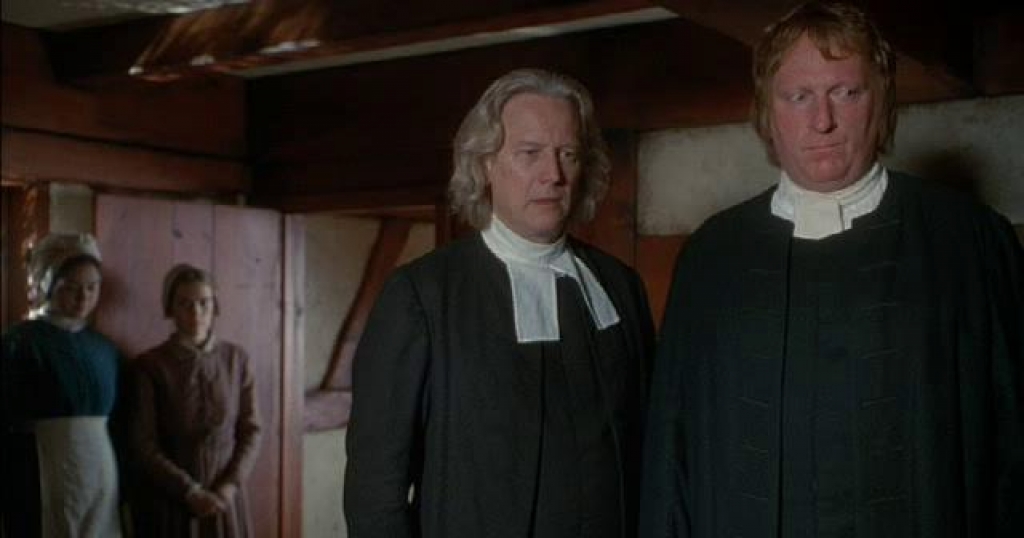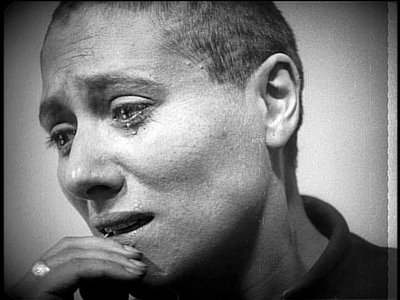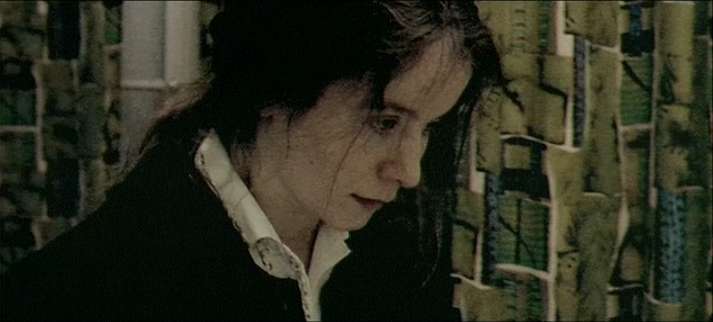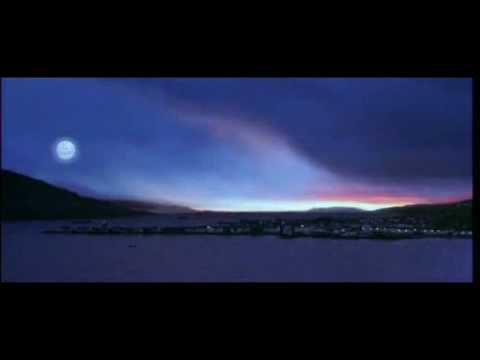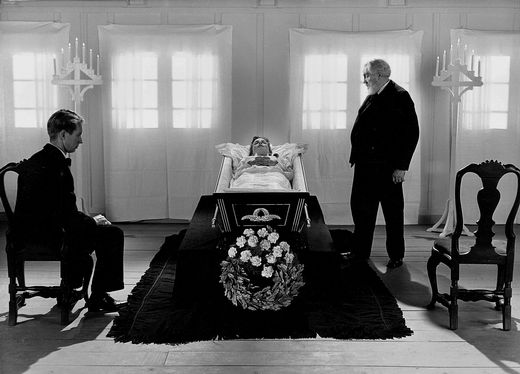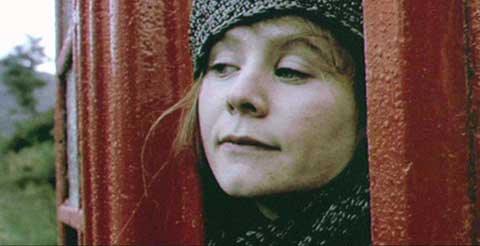From the Chicago Reader (December 6, 1996). – J.R.
Breaking the Waves
Rating *** A must see
Directed and written by
Lars von Trier
With Emily Watson, Stellan
Skarsgard, Katrin Cartlidge,
Jean-Marc Barr, Adrian Rawlins,
Jonathan Hackett, and Udo Kier.
Ever since I first encountered Lars von Trier’s Breaking the Waves in Cannes, where it won the grand jury prize, I’ve been debating within myself about it, because I find it simultaneously shameless, boldly original, contrived, highly affecting, transparent, cynical, hopeful, ironic, sincere, ugly, beautiful, and downright baffling. In a way, my debate isn’t so different from that of Bess (Emily Watson) — the innocent and high strung (or unstrung) young heroine who lives on the northwest coast of Scotland in the early 70s and for much of the film carries on a furious internal debate with “God,” speaking her own part in a squeaky high voice and God’s in a patriarchal low one.
Where Bess, a devout believer, has God, I, a nonbeliever, have the late Carl Dreyer, the film artist von Trier and I both revere above all others. And where Bess speaks to herself not as God but as her sense of God (which overlaps on rare occasion with her sense of Jan), I speak to myself not as Dreyer but as my sense of Dreyer’s achievement (which overlaps on rare occasion with my sense of von Trier’s achievement).
Considering how rarely Dreyer’s films are shown these days, bringing him up may seem more than a little esoteric. But Dreyer’s work has direct bearing on many basic issues raised by Breaking the Waves — about film, about religion, and about the whole notion of “good works,” in both ethical and aesthetic terms. Even who Dreyer was plays a significant role. Look him up in the standard American reference work, Ephraim Katz’s The Film Encyclopedia, and you read, “He was brought up by a strict Lutheran family.” But read the only comprehensive Dreyer biography, by Maurice Drouzy (unpublished in English, though available in Danish and French), and you discover this is completely false. Ib Monty, director of the Danish Film Archives, knew Dreyer pretty well, and he once told me that Dreyer wasn’t especially religious, even though some of his best-known features (The Passion of Joan of Arc, Day of Wrath, Ordet) address religious issues. (Von Trier, a Dane and self-styled Dreyer disciple, describes himself as a recent convert to Roman Catholicism, but it’s questionable whether this has as much bearing on his work as Dreyer’s beliefs had on his.)
Because Dreyer never established himself commercially during the sound period, his output from the 30s on was minuscule — roughly one feature per decade — though his influence continues to be enormous, even when it’s subterranean. (It’s doubtful, for example, that Arthur Miller would have written The Crucible if Day of Wrath hadn’t been released in the U.S. five years earlier; and the camera angles of the forthcoming movie of the play [see below] bear some unmistakable suggestions of Dreyer’s influence.) Von Trier, who hit the world market a dozen years ago with The Element of Crime, has been much more successful (if much less influential): he’s also made Epidemic (1987); Medea, based on an unfilmed Dreyer script (1988); Zentropa (1991); the enormously successful Danish miniseries The Kingdom (1994; a second cycle of episodes is now being filmed); and Breaking the Waves. He’s also been working for years on an eccentric thriller, Dimension, filmed in three-minute segments once a year, which is scheduled for completion in 2004.
Part of what’s least Dreyer-like about Breaking the Waves is von Trier’s calculated and postmodernist sense of film reference. Yet the film’s intensity, and therefore its power, is related to its models. In an interview Emily Watson mentions von Trier asking her to study Renee Falconetti in The Passion of Joan of Arc (1928) and Giulietta Masina in Fellini’s La strada (1954). The grotesque incompatibility of these two models of innocent female suffering — Falconetti’s raw, carnal martyrdom and Masina’s hammy, pop-eyed Harry Langdon imitations — suggests a lack of true respect for either Dreyer or Fellini. But traces of these films are indeed visible in Watson’s performance, so perhaps this dismissal is too hasty. And much as I hate to admit it, my conflicted response to von Trier’s film, my simultaneous desire to denounce and embrace it, is similar to my initial responses to Day of Wrath and Ordet when I was a teenager.


Nonetheless, the cynicism and shameless crudity of von Trier’s plot and dramaturgy make it impossible to consider him seriously alongside Dreyer. (Just as von Trier gets Watson to conflate Falconetti and Masina, he himself conflates Dreyer and Douglas Sirk –a cynical soap-opera specialist in Germany and Hollywood who distanced himself from his pile-driver effects with layers and layers of irony — or, perhaps even closer to the mark, Sirk’s sadistic postmodernist disciple of the 70s, Rainer Werner Fassbinder, who gets even more mileage out of photogenic suffering.)
In short, Breaking the Waves aggravates and perplexes me, proposing a critical conundrum that, I reluctantly confess, can only grow out of something new and interesting. Five years ago Zentropa struck me as a technical tour de force that was emotionally hollow — unlike Medea, which does powerful things with its actors and landscapes (even if it plays havoc with Dreyer’s script and might just as well have gone back to Euripides). Part of me would like to say that the achievement of Breaking the Waves is that for long stretches it doesn’t seem emotionally hollow — that it’s a very clever con game, a faux-naif masterpiece (unless one rejects the category as a contradiction in terms).
The film unravels in two diametrically opposed camera and editing styles — neither of which has any obvious relation to Dreyer, but that together create a dialectic that is clearly Dreyer-esque, above all in combining narrative and nonnarrative modes of perception. Though the style carrying the narrative may seem more important than the style carrying the meditative, nonnarrative landscape shots behind eight successive “chapter headings,” the two are equally important to what the film is doing as a whole. (Indeed, their juxtaposition is so dramatic that it’s easy to remember the landscape shots being much longer than they actually are.)
The aggressive “narrative” camera style consists of improvised, dizzying hand-held movements (the cinematography is credited to Robby Müller, a Dutch cinematographer best known for his work with Wim Wenders and Jim Jarmusch) and broken up by repeated jarring jump cuts that are like a needle skipping across a record. The color of the super-35-millimeter ‘Scope footage has been partially bleached out from having been transferred to video and then back to film.
By contrast, the “nonnarrative” camera style consists of panoramic shots of locations that have been digitally “painted” to achieve high resolution and vivid colors. Each of these shots runs about a minute and is accompanied by portions of a pop record of the early 70s and by a chapter number and title (“Chapter Two,” for instance, is “Life With Jan”); the camera remains stationary, but at least one element in each landscape — usually water or fog, occasionally light — is in flux. Broadly speaking, the narrative style carries a rhetoric closely associated with raw documentary, while the nonnarrative style, at once kitschy and beautiful, calls to mind picture postcards and lava lamps with panoramic shades. (Camera movement, stasis, and abrupt cuts are all central elements in Dreyer’s art, but his use of them is radically different in both meaning and effect; von Trier’s jazzier techniques come across like postmodernist pastiches. There’s no equivalent in Breaking the Waves, for instance, of the technique Dreyer invented of having the camera pan and track in different directions at the same time.)
There are many ways of describing the dialectical relation between these narrative and nonnarrative styles. (The narrative style also contains a dialectic all its own — between the freedom of the shooting style and the brutal interruptions and curtailments of the editing. The shooting style suggests unfettered desire, the editing compulsive behavior — which together express the film’s ambiguity about Bess’s state of mind.) If the narrative style is about action and passion, the nonnarrative style is about meditation, about action and emotion recollected in tranquillity.
Von Trier has described the nonnarrative interludes as a “God’s eye view of the landscape in which this story is unfolding, as if He is watching over the characters.” This may describe the film’s final shot, but the landscapes behind the chapter headings are obviously linked to the consciousness of Bess — unless von Trier means to imply that God’s taste and innocence are somehow equivalent to hers. But judging from his other comments about the story — such as “There are no bad guys, only misunderstandings,” which overlooks a good deal of gratuitous cruelty on the part of the villagers and outright savagery on the part of a sailor played by Udo Kier — he’s often as confused about what he’s doing as Bess is about what she’s doing.
“Can you think of anything the outsiders have brought with them?” one of the stern church fathers asks Bess at the beginning of the film, a reference to visiting oil riggers. She replies, “Their music.” A moment later, outside the church, she smiles directly at the camera, and we see the first chapter heading and hear the first pop song (“Bess Gets Married” and “All the Way From Memphis”). Jan, the oil rigger she falls in love with, is played by a Swedish actor (Stellan Skarsgard), but he seems meant to be taken as an American, like most of his coworkers; in some respects Bess’s bond with him can be taken as an allegorical version of von Trier’s hankering after Hollywood, roughly akin to the role Harvey Keitel played for Jane Campion (and Holly Hunter) in The Piano. (Though the dialogue of Breaking the Waves is in English — as it was in The Element of Crime — the shooting was done in Denmark and Scotland. The original story was set in a fishing community on Denmark’s west coast, where a strict puritan sect known as the Inner Mission — a sect that plays an important role in Dreyer’s Ordet — rules; when von Trier decided to shift his story to Scotland, the Free Church was substituted.) However, Bess smiling directly at the camera is an early indication of von Trier’s ironic distance from his material, which places him at a further remove from Hollywood.
Bess’s obsessive infatuation with Jan — which makes most of the villagers conclude she’s not quite right in the head and increases their disapproval when she marries him — is exacerbated when he goes back to work on the rig. She prays for his early return, finding life without him unbearable. When a serious accident paralyzes him from the neck down, ensuring his immediate return, she becomes convinced that her prayers were responsible. He is guilt stricken by her continuing devotion and tries to persuade her to take a lover. She recoils in rage, but he gradually persuades her that if she has sex with other men and tells him about her experiences it will keep him alive. I won’t try to synopsize the remainder of the plot, which turns progressively more extreme and melodramatic, except to say that it concludes with a tragedy followed by a pair of miracles directly inspired (albeit crudely) by the conclusion of Ordet.
The crucial difference between this film’s conclusion and that one’s is that Dreyer’s — which takes a position regarding content that has radical formal implications — characteristically poses a challenge to religious belief and disbelief alike. Von Trier’s no less characteristically heaps on so many layers of postmodernist irony about truth and faith that isolating any form of belief or disbelief from the resulting tangle becomes impossible: style becomes almost everything, content next to nothing. I assume this is at least partly what New City‘s Ray Pride had in mind when he concluded, “Perhaps only a cynic like von Trier could make a film so unabashedly, so heroically heartfelt.” Von Trier is certainly honest about his dishonesty. Like other postmodernists, he’s merely working with what he has.
I’m far from sharing von Trier’s cynicism, but I think there are many reasons for respecting it, most of them generational. People born before 1950 often had good reason to feel hopeful, at least during the late 60s and 70s; those born later — von Trier was born in 1956 — had less and less reason to feel that way. A massive backlash against the earlier generation’s optimism is still going on, an indication of how potent the optimism was. (Evidence of the backlash could be seen in this year’s political campaigns, in which “liberal” was still a dirty word.) Within such a context, a passionate desire to create and even respect a character like Bess — however many stylistic and thematic paradoxes this entails — is clearly a heroic aspiration.
Von Trier may be deeply cynical, but he’s much less so than Terrence Rafferty was when he recently wrote in the New Yorker, “If Breaking the Waves becomes a hit, von Trier will have proved that the American audience for foreign films wants today precisely what it wanted in the boom years of the 50s and early 60s: nudity plus theology.” A little later he added, “It’s tempting to attribute the decline of the European film to the increase, over the years, in the erotic explicitness of American movies.” When he says “decline” and “the European film” it can only be in the context of the American marketplace — specifically the European films selected by American distributors, the tip of the iceberg Rafferty seems happy to accept as the whole. Apparently he believes the only reason films are made in Europe is to satisfy Americans who want to see tits and ass mixed in with their theology, and if these needs can’t be met European filmmakers might as well hand over their assignments to “pure” American artists working free of such pressures (say, Brian De Palma in Mission: Impossible, a recent Rafferty favorite).
I can’t recall much nudity or theology in European movies such as Mon oncle, Breathless, The 400 Blows, Jules and Jim, Last Year at Marienbad, Eclipse, Ashes and Diamonds, or The Magician — to cite only a few of my favorites that did well during those “boom years” (alongside such commercial flops as Pickpocket, Lola, and Dreyer’s Gertrud). So I guess if American viewers are the nincompoops Rafferty claims, they must have had other dumb reasons for going to these films. (One important factor may have been the proliferation of independent art theaters during that era, when antitrust laws were still being enforced — in contrast to today, when Chicago has only one independent first-run commercial theater showing foreign movies, the Music Box.)
So far Breaking the Waves hasn’t become a hit, at least not in this country, but there are still other dumb reasons to see it, including the performances; Katrin Cartlidge as Bess’s devoted sister-in-law, a part virtually antithetical to her role in Naked, is almost as good as Watson. There’s also the gripping story, the two camera and editing styles and their relation to each other, and even the implications of a postmodernist manifesto about the possibilities of truth and sincerity for someone of von Trier’s generation. Finally there’s the fact that no other movie around is even remotely like it.
I can certainly understand Rafferty’s anger at the sarcasm and falsity underlying von Trier’s approach — since I become angry every time I think of Breaking the Waves “replacing” Ordet (though that’s surely a false syllogism). But it’s worth pointing out that von Trier is willing to test and challenge his own sarcasm, not merely cling to it like a life raft. In an interview with Stig Bjorkman in the Village Voice he describes how his collaboration with painter Per Kirkeby on the chapter-heading panoramas altered his view of their function in the film: “I wanted, above all, for him to find different expressions for the Romantic landscape. I was of the opinion that this Romanticism would expose a greater banality, but Kirkeby’s first suggestion distanced itself quite considerably from that view. The final result could perhaps be described as a diplomatic mix of his and my ideas.”
A less sympathetic reading of this flexibility might be that von Trier is “too cynical to believe even his own cynicism” — as Andrew Sarris once said of Billy Wilder. But I would prefer to regard Breaking the Waves as a search for belief that acknowledges the land mines separating a 70s consciousness from that goal, a search that burrows ever deeper into irony and ambiguity without reaching the sincerity it strives for — but without collapsing into the nihilism that I see all around me in commercial fare (and even stylish variants of that fare, such as Mission: Impossible).
Is Breaking the Waves a religious film? I doubt that von Trier knows the answer to that question — just as I doubt that Dreyer would have known the answer if he’d been asked the same question about Ordet. A vast universe of thought, feeling, and artistry divides the two films, made over 40 years apart, but this uncertainty is the point at which both of them become interesting.


